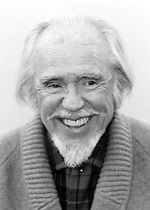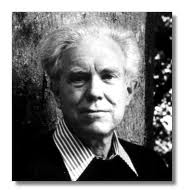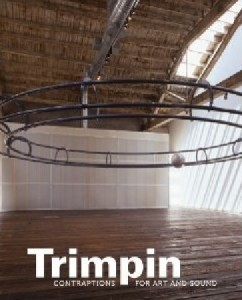 The current issue of the journal American Music (Volume 29, No. 1) contains an article by my Serbian musicologist friend Dragana Stojanovic-Novicic titled “The Carter-Nancarrow Correspondence.” It will doubtless be available on the web via JSTOR soon, and if you’re not in academia (we professors can access it for free), a private subscription to JSTOR would be well worth the money; I’d say 85% of the footnotes in my scholarly writing lately are references to articles i’ve found there. Dragana is the person who has gone most thoroughly through Nancarrow’s correspondence, and she has another article in process for Musical Quarterly on his letters to and from Gyorgy Ligeti. I’m urging her to write the first Nancarrow biography, because she’d do a hell of a job, and she’s taught me a lot about his life.
The current issue of the journal American Music (Volume 29, No. 1) contains an article by my Serbian musicologist friend Dragana Stojanovic-Novicic titled “The Carter-Nancarrow Correspondence.” It will doubtless be available on the web via JSTOR soon, and if you’re not in academia (we professors can access it for free), a private subscription to JSTOR would be well worth the money; I’d say 85% of the footnotes in my scholarly writing lately are references to articles i’ve found there. Dragana is the person who has gone most thoroughly through Nancarrow’s correspondence, and she has another article in process for Musical Quarterly on his letters to and from Gyorgy Ligeti. I’m urging her to write the first Nancarrow biography, because she’d do a hell of a job, and she’s taught me a lot about his life.
 According to the article, Carter studied Spanish briefly with Nancarrow, who had just returned from fighting in the Spanish Civil War. One of Carter’s first letters to Nancarrow, from as early as 1939, asked about the possibility of his writing a ballet for Lincoln Kirstein’s Ballet Caravan, for which Carter was then music director; obviously this never came to pass. Can you imagine an early Nancarrow ballet? What a wrinkle in music history that would have caused. The letters document aesthetic agreements and disagreements between the two composers. Nancarrow loved Carter’s First String Quartet (which rhythmically quotes Nancarrow, though opinions differ as to where), Cello Sonata, and Double Concerto, but liked the second movement of the Piano Sonata better than the first: “For me the complex rhythms simply don’t sound” (1952). Composer of perhaps the most complex rhythms ever penned, Nancarrow was dismissive of complexity for its own sake, and brought this charge against Messiaen, no less, in 1957: “Messiaen’s music looks complex and sounds even more so, a muddy mess.” (I wonder what he was looking at. Though reclusive, Nancarrow subscribed to all the major new-music journals.) For his part, Carter left Nancarrow “disillusioned” by admitting that he couldn’t understand “by ear” the mathematics of the acceleration canons of Nancarrow’s Study #23, of which the latter had sent an enthusiastic analysis. Nevertheless, for decades Carter expressed warm solicitude for getting Nancarrow’s music out (the longest hiatus in their surviving correspondence was from 1974-87), and in 1968 even invited Nancarrow to come stay with him and his wife in Rome. One is struck by how much earlier Nancarrow could have ventured into the professional world had he only taken advantage of his opportunities. Dragana’s footnotes are among the longest and most detailed in the musicological literature, and she’s an incredible stickler for exactitude of expression. I won’t give away any details yet from the Ligeti article (I help her make her translations from Serbian idiomatic), but it’s, if anything, even more enlightening.
According to the article, Carter studied Spanish briefly with Nancarrow, who had just returned from fighting in the Spanish Civil War. One of Carter’s first letters to Nancarrow, from as early as 1939, asked about the possibility of his writing a ballet for Lincoln Kirstein’s Ballet Caravan, for which Carter was then music director; obviously this never came to pass. Can you imagine an early Nancarrow ballet? What a wrinkle in music history that would have caused. The letters document aesthetic agreements and disagreements between the two composers. Nancarrow loved Carter’s First String Quartet (which rhythmically quotes Nancarrow, though opinions differ as to where), Cello Sonata, and Double Concerto, but liked the second movement of the Piano Sonata better than the first: “For me the complex rhythms simply don’t sound” (1952). Composer of perhaps the most complex rhythms ever penned, Nancarrow was dismissive of complexity for its own sake, and brought this charge against Messiaen, no less, in 1957: “Messiaen’s music looks complex and sounds even more so, a muddy mess.” (I wonder what he was looking at. Though reclusive, Nancarrow subscribed to all the major new-music journals.) For his part, Carter left Nancarrow “disillusioned” by admitting that he couldn’t understand “by ear” the mathematics of the acceleration canons of Nancarrow’s Study #23, of which the latter had sent an enthusiastic analysis. Nevertheless, for decades Carter expressed warm solicitude for getting Nancarrow’s music out (the longest hiatus in their surviving correspondence was from 1974-87), and in 1968 even invited Nancarrow to come stay with him and his wife in Rome. One is struck by how much earlier Nancarrow could have ventured into the professional world had he only taken advantage of his opportunities. Dragana’s footnotes are among the longest and most detailed in the musicological literature, and she’s an incredible stickler for exactitude of expression. I won’t give away any details yet from the Ligeti article (I help her make her translations from Serbian idiomatic), but it’s, if anything, even more enlightening.
 By coincidence, as I was writing this, a copy arrived of the book Trimpin: Contraptions for Art and Sound, compiled and edited by Anne Focke (U. of Washington Press). It contains my article “Trimpin, Nancarrow, and the Transfer of Memory,” along with articles on Trimpin by Charles Amirkhanian, Steve Peters, David Mahler, David Harrington, and others. Along with my Ashley book (which I’m finishing up the final re-edits on), I’ve got three more articles coming out in books this fall: forewords to Ashley’s Perfect Lives and the 50th-anniversary edition of Cage’s Silence, and an article on John Luther Adams’s orchestral music in Bernd Herzogenrath’s book on him, The Farthest Place. I’ve spent the last two years writing like a scholarly madman, and the results are now appearing in quick succession. But this summer: only composing, smoking cigars, and drinking 18-year-old Bowmore. I’ve earned the respite, I’d like to think.
By coincidence, as I was writing this, a copy arrived of the book Trimpin: Contraptions for Art and Sound, compiled and edited by Anne Focke (U. of Washington Press). It contains my article “Trimpin, Nancarrow, and the Transfer of Memory,” along with articles on Trimpin by Charles Amirkhanian, Steve Peters, David Mahler, David Harrington, and others. Along with my Ashley book (which I’m finishing up the final re-edits on), I’ve got three more articles coming out in books this fall: forewords to Ashley’s Perfect Lives and the 50th-anniversary edition of Cage’s Silence, and an article on John Luther Adams’s orchestral music in Bernd Herzogenrath’s book on him, The Farthest Place. I’ve spent the last two years writing like a scholarly madman, and the results are now appearing in quick succession. But this summer: only composing, smoking cigars, and drinking 18-year-old Bowmore. I’ve earned the respite, I’d like to think.
